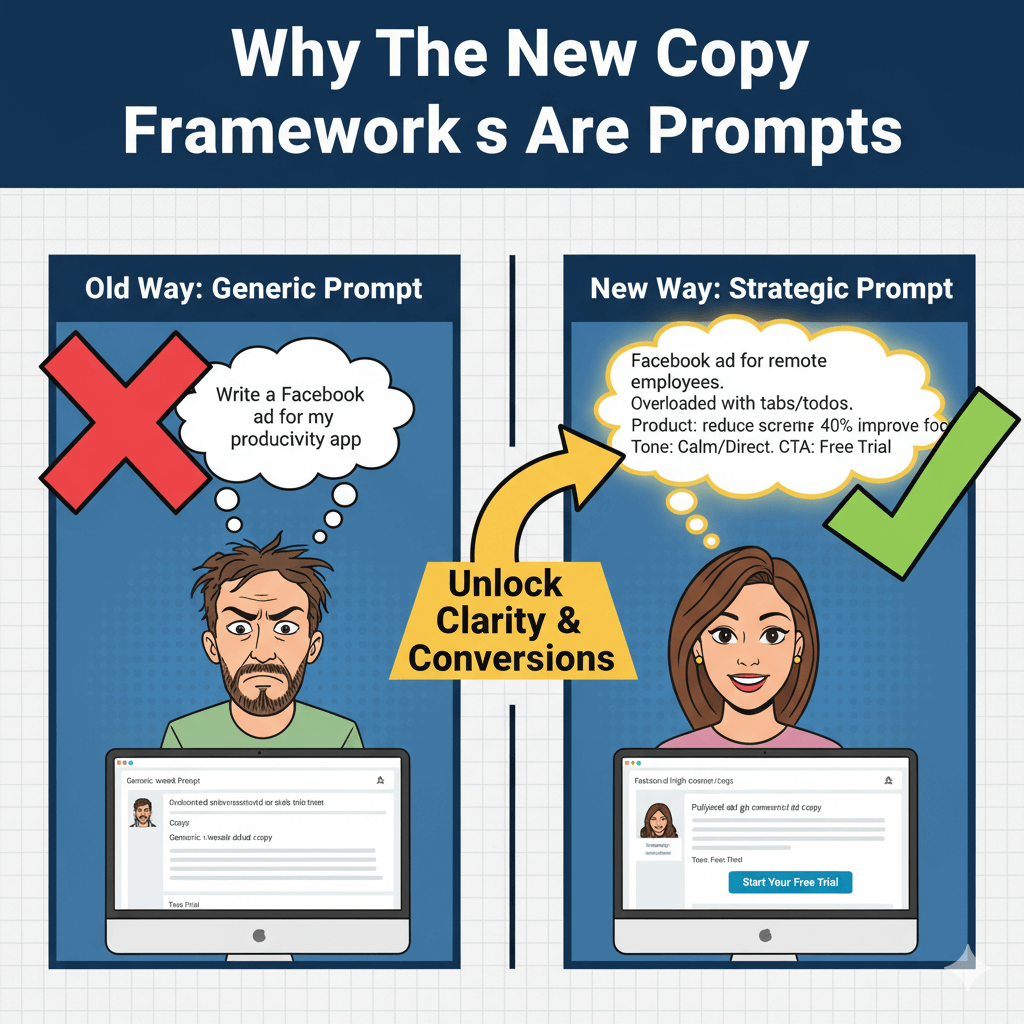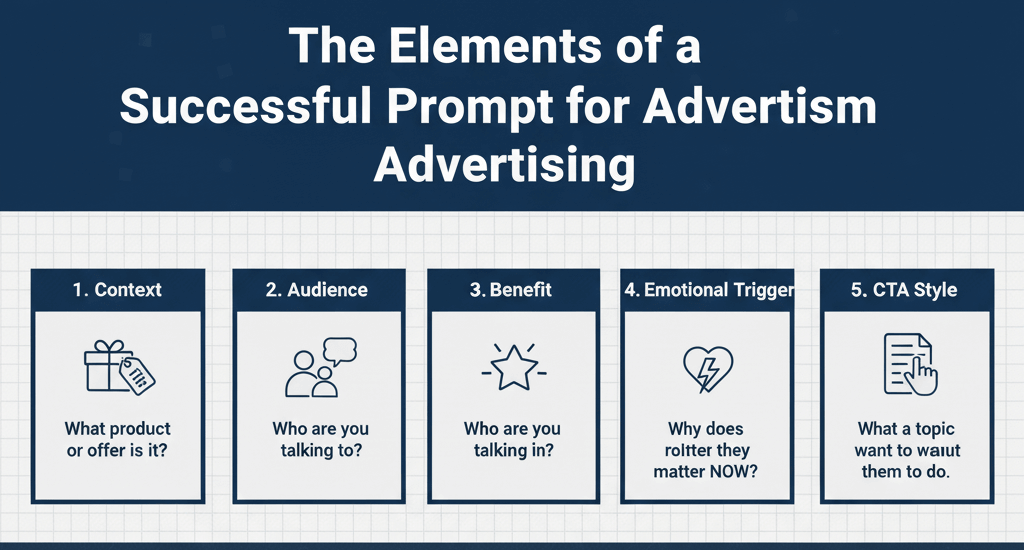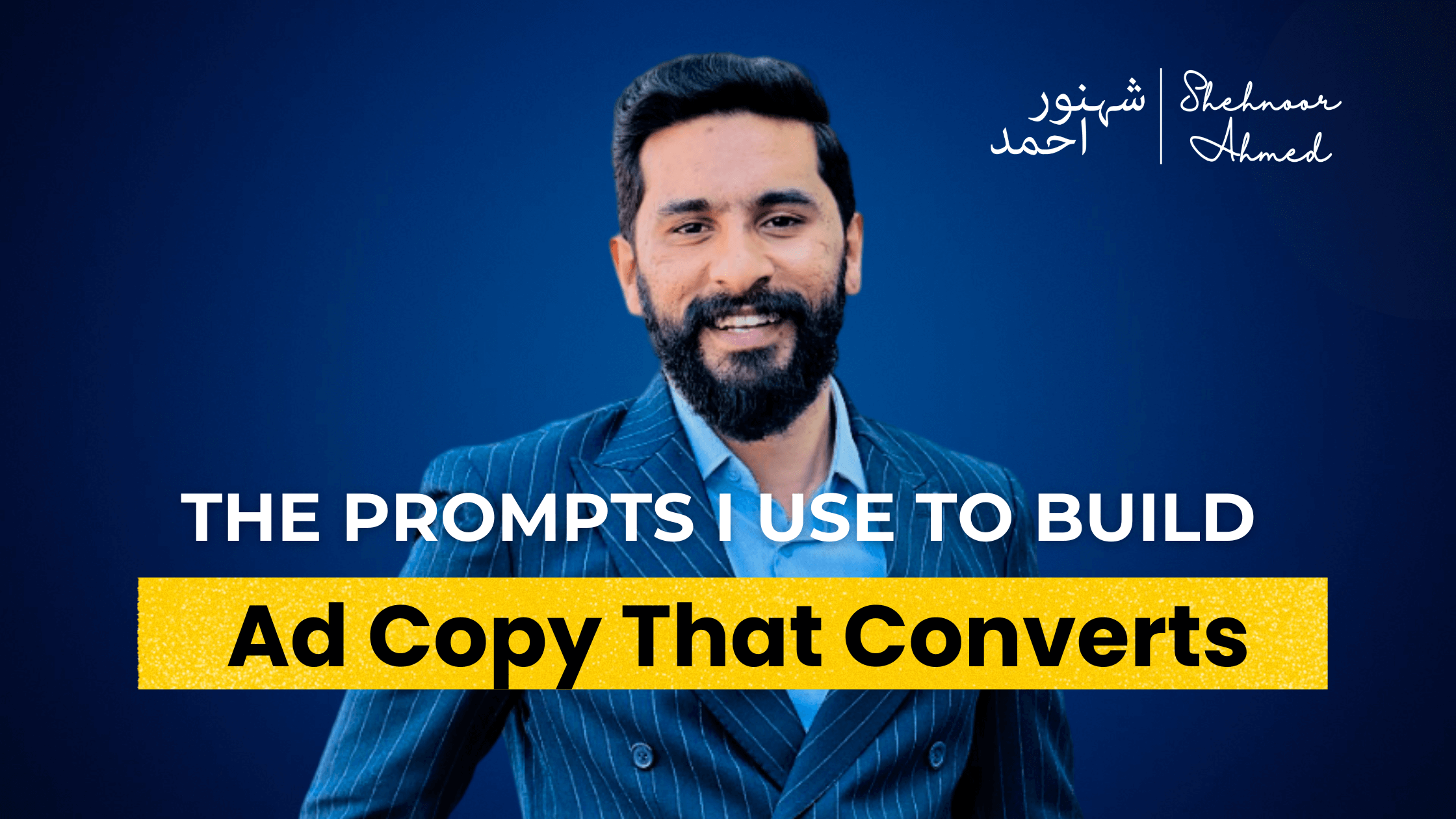“Most marketers write ads by guessing. Others follow random templates. The pros? They start with the right thinking prompts, and it shows in their conversions.”
If you’ve ever written an ad that felt flat, vague, or forgettable, you’re not alone. The real issue isn’t your writing, it’s your starting point.
This article shares the exact prompts and thought frameworks I use to create scroll-stopping, high-converting ad copy across Facebook, Instagram, Google, landing pages, and email.
No fluff. Just proven techniques.
Why the New Copy Frameworks Are Prompts

You can use prompts for more than just brainstorming. They are tools for strategy.
They assist you to:
- Make the message clear
- Organise your advertisement
- Strike emotional triggers
- Keep the copy benefit-focused
Excellent prompts help you save time. They eliminate uncertainty and maintain consistency in your messaging without sacrificing uniqueness or personality.
You don’t have to start from scratch every time. All you need is a distinct framework to work within when crafting your message.
The Elements of a Successful Prompt for Advertising
Every effective ad starts with these five elements:
- Context: What product or offer is it?
- Are you addressing the audience?
- What can they benefit from?
- Why is emotional trigger important right now?
- In terms of CTA style, what do you want them to do?
The prompt “Write a Facebook ad for my productivity app” is not sufficiently strong.
The output was generic, unremarkable, and lacked perspective.
Strategic Prompt:
“Make a Facebook ad targeting remote employees who feel overloaded with tabs and to-do lists. The product helps reduce screen time by 40% and improves focus. Calm but direct tone. The CTA should offer a free trial.”
An illustration of edited copy:
Do you have too many tabs and tasks? Reclaim your day by using our easy-to-use productivity app. Cut back on screen time, focus more intently, and then take a break. Start your free seven-day trial right now.
Do you notice the difference?
Intelligence has no bearing on it. It all boils down to being emotional, realistic, and intelligible.
Examine These 5 Tried-and-True Prompts (With Use Cases)

1. Ad Hook Prompt for Facebook
When to use it: An attention-grabbing introduction is necessary.
The assignment: Create an intriguing Facebook ad hook for a . The target audience is experiencing pain.
For instance:
“You’re not lazy. You simply have a broken to-do list. In five minutes, fix it.”
2. An Urgent Instagram Caption
When to use: Limited-time deals or product discontinuations.
Prompt: Write an Instagram caption that increases the urgency of [offer]. One benefit and one line motivated by FOMO should be included. The tone should be bold and quick.
For instance:
“Just 72 hours remain! Use SmartRank Pro to rank higher and get rid of your antiquated SEO tools. It’s gone once it’s gone.”
3. Variations in Google Ad Headlines
When to use: Ad headlines for A/B testing.
Task: Provide me with five Google AdWords headlines for that highlight [audience]’s [benefit].
For instance:
- Increase focus by 40%
- Make Your Workflow Simpler
- Tools to Help Creators Focus
- Reduced noise. More completed.
- Try It Free Without a Card
4. CTA Reframe for Landing Pages
When to apply: Your call to action seems flimsy or generic.
Prompt: Reword this call to action on the landing page to make it sound more emotionally urgent and benefit-driven: [Insert the most recent CTA]
For instance:
- Old: “Start Free Trial”
- New: “Take Back Two Hours a Day,Try It Free”
5. Cold Lead Email Ad
When to apply: Presenting a product to untapped markets.
Prompt: Send a brief email introducing to cold leads. Position the product lightly after hooking it with a pain point. Low pressure should be felt by the CTA.
For instance:
Subject: Are you still overwhelmed by deadlines?
Body:
The majority of tools produce noise. It’s ours.
Busy marketers can recover time and clarity with SmartFocus.
Try it for free for seven days without a card or spam.
Great Ideas Are the Foundation of Great Writing
A draft is what your initial version is. What sells is your rewrite.
How I Edit Draft Text to Increase Conversion
Here’s how I turn rough drafts into polished, effective advertisements:
- Eliminate weak words: “nice” → “clear,” “good” → “strong,” “make better” → “transform”
- Replace clichés: “Unlock your full potential” → “Finally focus without the noise”
- Tighten: Eliminate superfluous words. Reach the advantage more quickly.
- Test it aloud: If it sounds monotonous or robotic, revise it.
Bonus Advice
Don’t let the pitch be written by your prompt. Allow it to reveal the angle.
The closer is you.
What Both Google and People Want in Ad Copy: SEO & Authority
Search engine optimisation is still possible for short ad copy:
- Don’t stuff keywords; instead, use natural keywords
- Adapt your wording to what actual users are looking for
- Align the copy, not just the product, with the suffering
- Clarify your brand: Why should I trust you, and who is this for?
Remember: Authority counts. Clarity, credibility, and value are what matter, whether it’s a Google Ad or a brief Instagram caption.
Tools I Use for Writing, Polishing, and Prompting Copy
| Goal | No-Cost Plan? | A Standout Feature |
|---|---|---|
| My Quick Frameworks | Yes | Starting points for strategy |
| Grammarly | Yes | Designed to convert grammar, tone, and clarity |
| Hemingway App | Yes | Recognise poor language, bold and readable |
| Notion | Yes | Arrange and evaluate variations |
Although the process is aided by these tools, strategy always comes first.
Things Not to Do When Requesting Ad Copy
Typical errors that prevent conversion:
- Composing without understanding the suffering of your audience
- Getting your first draft published
- Using a tone that is too rigid or generic
- Attempting to appear astute rather than straightforward
- Using haste without any true purpose
You’re not writing for yourself.
You’re writing for the person on the other side of the scroll, for the click, for the conversion.
Are You Prepared to Quit Speculating and Begin Creating Converting Ads?
Don’t reinvent the wheel if you’re sick of writing copy that seems “okay” but doesn’t convert.
Watch what changes after you start with the appropriate thought prompts.
Get my personal Prompt Pack, which contains the exact prompts I use to create ad copy that converts well.
Book 1:1 Consultancy with me at hello@shehnoorahmed.com

FAQs
Can I write better ad copy using prompts?
Yes, provided that they are precise, targeted, and centred on the mindset of your client.
How can I sound more like myself in my advertisements?
Make deliberate edits. Rewrite with your own words and voice. Speak like a human instead of using the “marketing voice.”
What constitutes a “high-converting” prompt?
It enables you to quickly, emotionally, and clearly deliver the right message to the right person.
What is the ideal length for a copy prompt?
Only a few lines. Not too much to be confusing, just enough to help focus.
Do I need to purchase tools?
No. Although tools are useful, strategy, structure, and intent are always more important.




